Interview Details
- Interviewee: One teacher who works with ELLs;
- Location: an English language classroom;
- Theme: How assessment is used for placement;
- Number of questions: 10;
- Time: approximately one hour;
- Main issues: assessment types, roles of parents and teachers, language proficiency.
To discuss the peculiar features of assessment and its connection to placement, one English language teacher is interviewed in an English language classroom. One hour is an approximate length of the interview. 10 open-ended questions are posed to the teacher. The goal of the interview is to explain how assessment can be used for placement, describe the types of assessment, discuss the role of parents and teachers for ELLs, and evaluate the level of language proficiency.
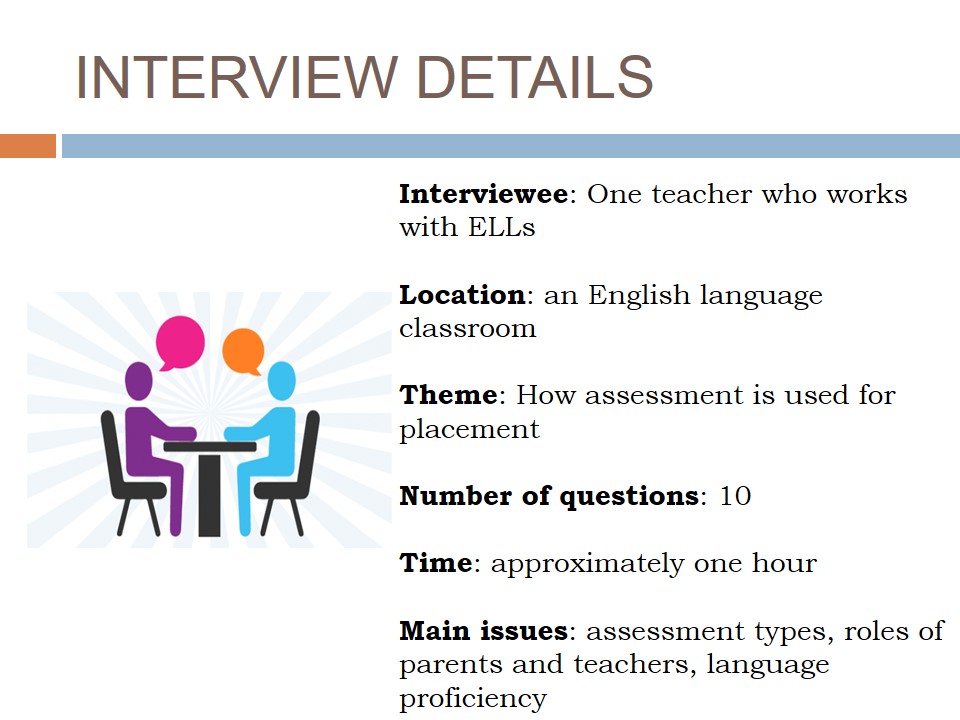
English Language Learners: FAQs
There are many ELLs in the United States. These learners are all students who may face certain language barriers due to a number of reasons (Alhasiany, 2014). Each state has its own statistics and a program to address the level of English language proficiency. Language barriers may be caused by migration that increases the number of minority students, poor education programs which do not give the same opportunities to all students, the presence of various placement types, and the inability to avoid cultural judgments and prejudices. Any classroom teacher has to recognize these indicators of exceptionality to help students avoid a language barrier.
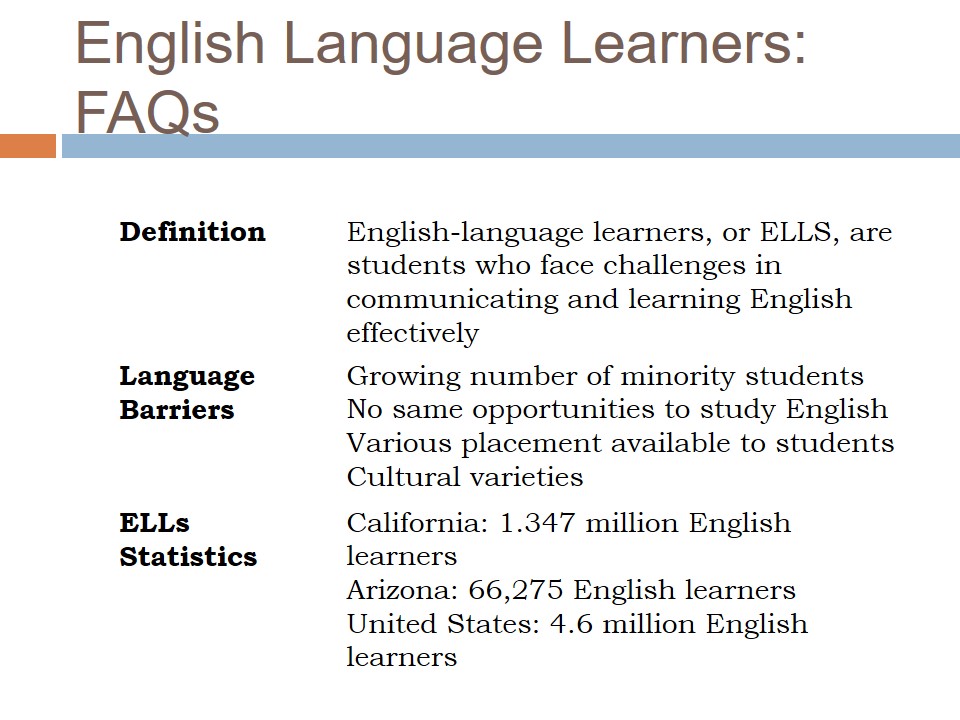
What Is Assessment?
Assessment is:
- a crucial part of teaching and classroom activities;
- a method to gather information about students’ skills and abilities;
- language testing that demonstrates student’s progress in English learning.
Language assessment plays an important role in teaching (Solano-Flores, 2016). Any language teacher has to estimate the possibilities and the level of knowledge of ELLs. Assessment is one of the methods that can be used to gather information about students, their skills, and their knowledge. As a rule, assessment gains a form of tests that are chosen by teachers in regards to students’ background and other important indicators of exceptionality. Besides, the identification of a state is integral in the choice of tests to be prepared for. Each state of America has its own standards and demands, and language teachers have to work in regards to the already defined rules.
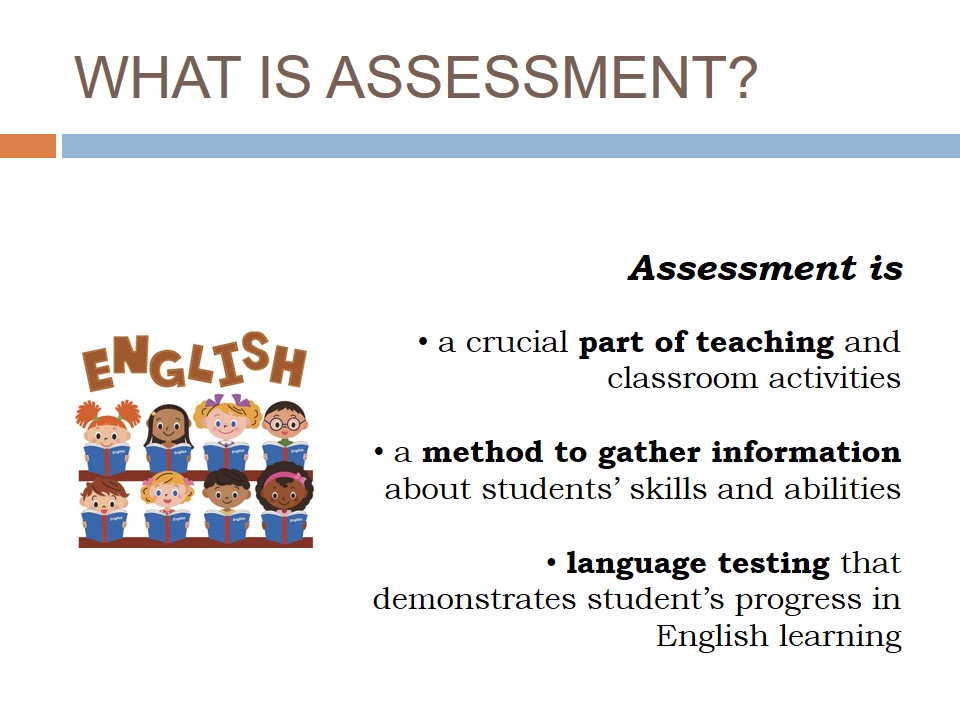
Placement Importance
Placement evaluation:
- Definition: the method to place students;
- Indicators: students’ prior achievements and personal characteristics;
- Period: prior to any instructions and interventions;
- Importance: to make the best and most effective ways of teaching and cooperating.
Learners’ assessment can be developed in a variety of ways. Placement assessment is one of the methods that can be used for assessment to clarify how to place students effectively. Placement is important because it helps to define students’ prior achievements in language and clarify their personal characteristics that can be used in a learning process. As a rule, placement has to occur before any instructions or interventions offered. Its importance is the possibility to make right choices and achieve the best outcomes in learning.

Formal vs. Informal Assessment
- Formal Assessment:
- Progress of a student compared to other students;
- Specialized tests and quizzes;
- Assessed by a state;
- Significant contribution to a final grade.
- Informal Assessment:
- Progress of a student compared to their past achievements;
- Classroom tests and quizzes, communication;
- Assessed by teachers, parents, and students;
- No significant contribution to a final grade.
There are two types of assessments that can be used in classrooms. Teachers can use formal assessment to identify students’ progress compared to each other. It is usually organized at the local or state level and determines a final grade of a student. There are many specialized tests that can be used to check students’ knowledge and achievements. Informal assessment is used irregularly to identify an individual progress of a student. Various quizzes and tests are used by parents or teachers to identify the achievements of a student. In comparison to formal assessment, informal assessment does not influence a final grade but demonstrates personal achievements and progress. Students can estimate each other.
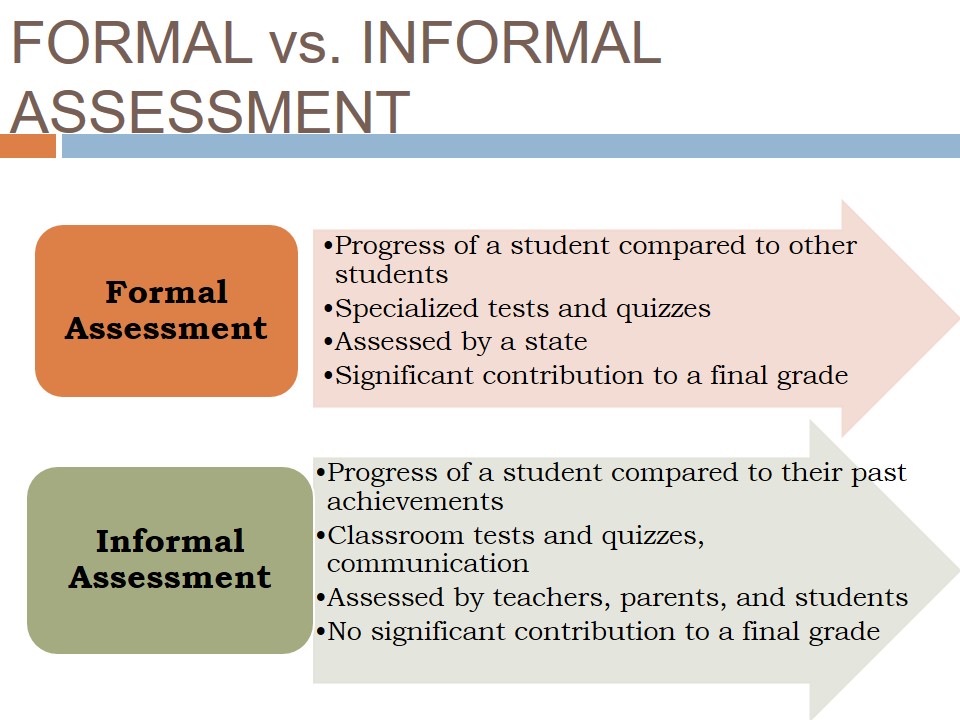
Roles of Parents and Teachers
Parents and teachers play an important role in assessment and placement.
- Parents:
- Assess student skills;
- Come up with educational goals;
- Keep an eye;
- Create continuity;
- Advocate interests.
- Teachers:
- Evaluate student knowledge;
- Investigate past education;
- Choose teaching methods;
- Instruct students;
- Identify current progress.
Parents and teachers are the main caretakers of students for a long period of time. Both groups play an important role in assessment and placing process. The tasks may vary. Still, the idea remains to be the same: help students achieve positive results in education. Parents may participate in assessing and placing students while assessing their skills, identifying educational goals, keeping an eye of students’ achievements, creating continuity, and even advocating interests of students. Teachers, in their turn, has to promote assessment and placement by means of evaluating student knowledge, investigating their past education, using the best methods for teaching, giving clear instructions, and investigating current academic progress.
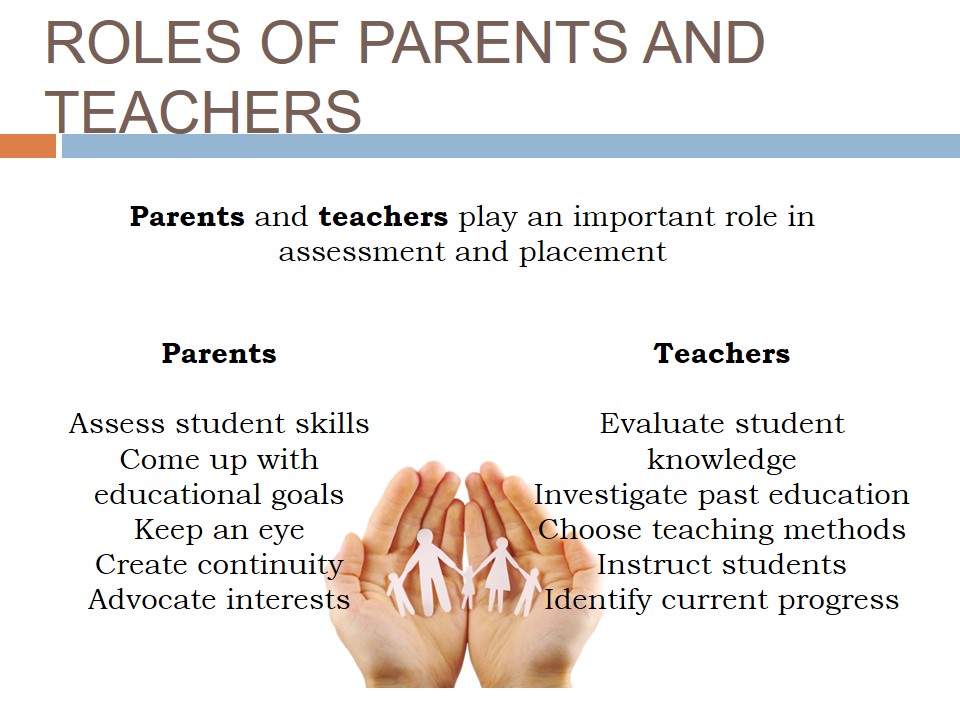
Underachievement Importance
Underachievement is:
- when student’s academic performance is below potential;
- when students are not interested in learning;
- when disparities in IQ tests are observed.
Underachievement is a common problem among ELLs. Primary factors that may be exhibited in underachievement include a low academic performance in comparison to the already identified potential, a low or absent interest in learning and the importance of gaining knowledge, and the existing disparities in IQ tests and grades that do not have clear reasons. It is a problem that has to be solved as soon as an appropriate assessment is organized.
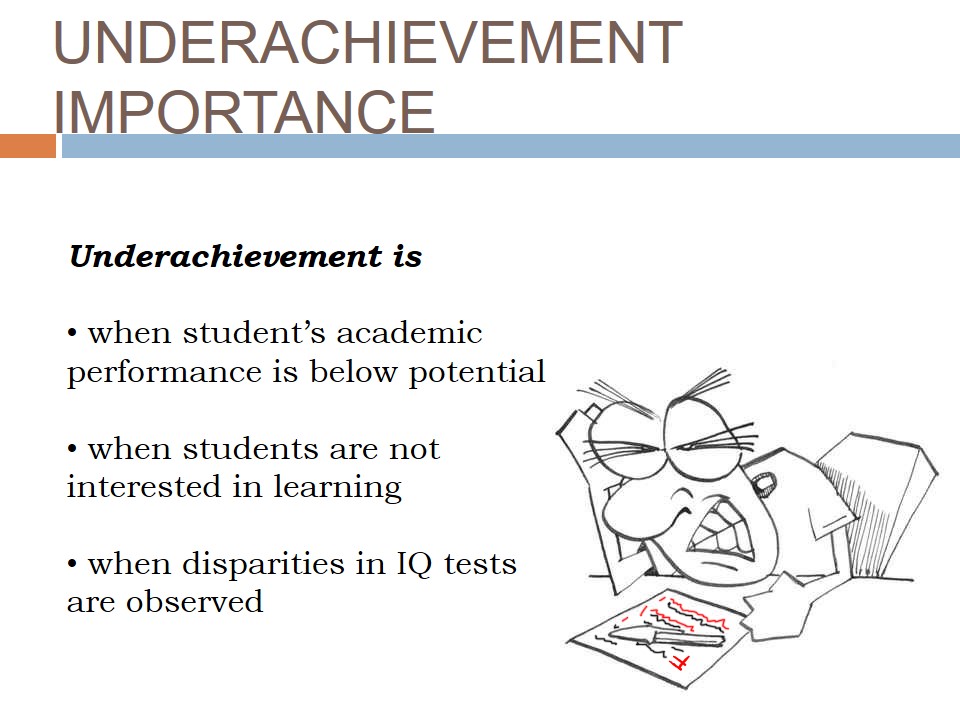
Students’ Changes
- One out of four American students are from immigrant families.
- Not all minority students use English as their main language for communication.
- 51% of ELLs increase is observed during the last decade.
- Local and federal laws are used to support ELLs.
In the interview with an English teacher, it is clarified that migration is the main reason for academic and performance changes in classrooms. There is approximately one student per four students who does not use English as their native language. Besides, not all ELLs are ready to use English as their main language for everyday communication. It is easy for them to use their native language outside, and speak English in classrooms only. The number of students has been increased by 51% in the United States. To support these minority students, local and federal laws are developed.
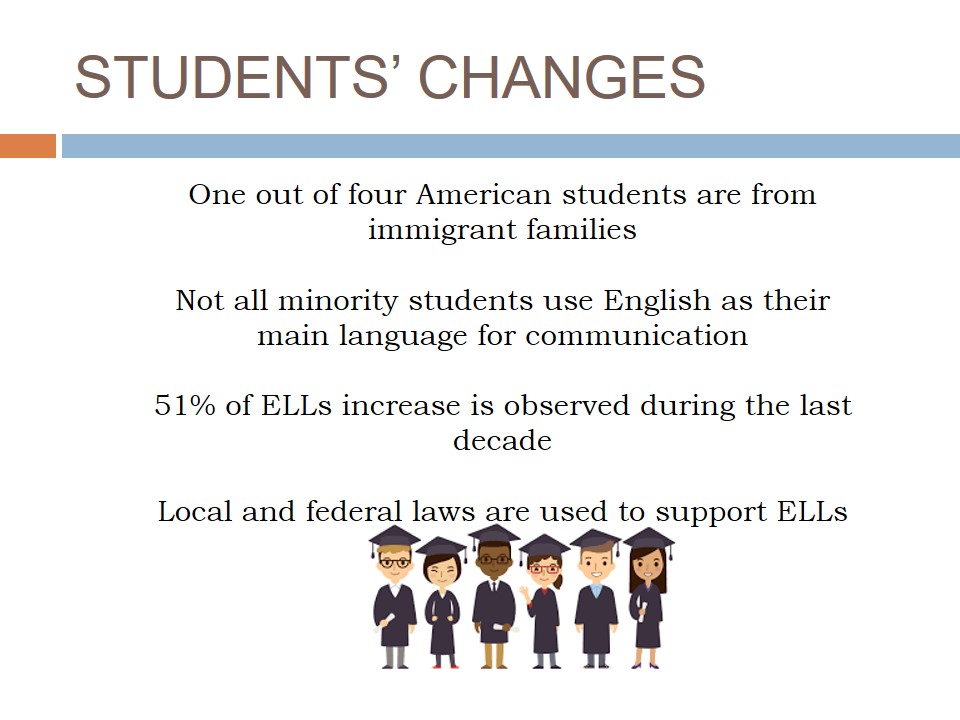
Types of Assessment
- Diagnostic Assessment:
- Before the instructions;
- Pre-assessment of skills;
- Student knowledge and skills;
- Ungraded tests and quizzes.
- Formative Assessment:
- During the learning process;
- Feedback on a learning process;
- Student abilities to answer questions;
- Ungraded dialogues.
- Summative Assessment:
- At the end of the learning process;
- Student progress against standards;
- Student abilities to comprehend instructions;
- Graded tests.
There are three types of assessment that can be used by teachers to estimate students’ level of knowledge and clarify what kind of work has to be done to help students achieve positive academic results. Diagnostic, formative, and summative assessment have their own characteristics. For example, each assessment has its own period:
- Diagnostic assessment occurs before any instruction is given and gains the form of pre-assessment of students’ skills. It aims at evaluation student knowledge and language skills. Teachers use tests and quizzes which should not be graded.
- Formative assessment occurs during the learning process to gather feedbacks on it. Teachers check student abilities to answer questions and demonstrate their knowledge. Ungraded dialogues can be helpful.
- Summative assessment occurs at the end of the learning process to estimate student progress and gained abilities compared to the already established standards. Students should demonstrate how they comprehend instructions and use their past experience through tests that can be graded.
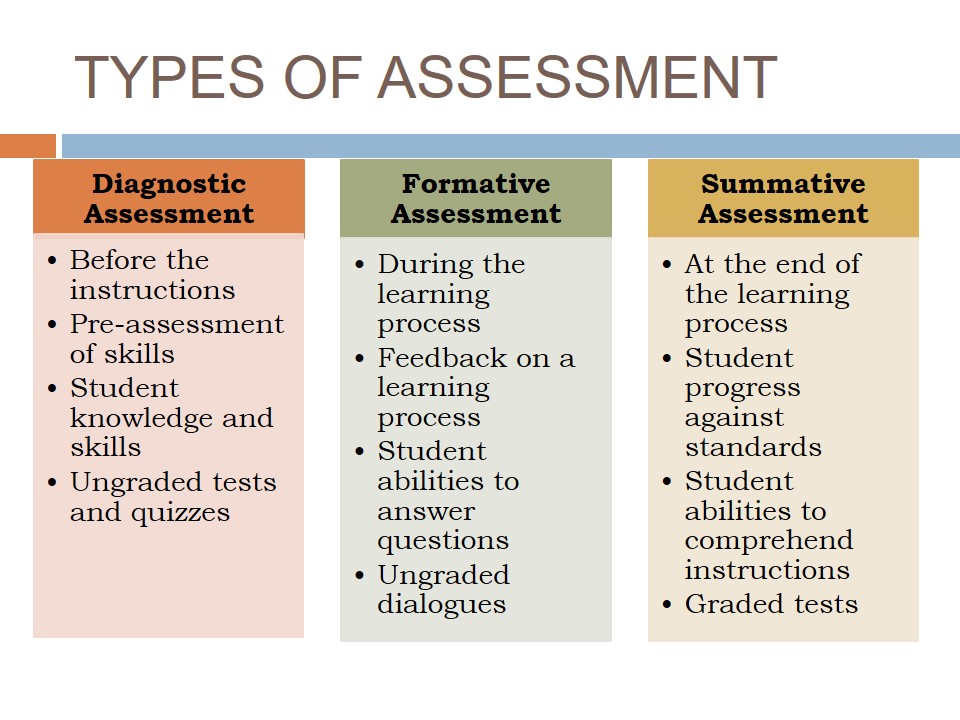
SIOP Protocol
SIOP stands for the Sheltered Instruction Observation Protocol.
The Sheltered Instruction Observation Protocol (SIOP) is an instructional model that is used to prove the effectiveness of instructions that are used to address ELLs’ needs. There are eight important components in the model, and each of them has its benefit for native English speakers, as well as for ESLs.
- Lesson Preparation –enough time to get prepared for lessons and evaluate information;
- Building Background – free demonstration of their cultural preferences and knowledge in a learning process;
- Comprehensible Input –clear instructions and explanations depending on their levels of knowledge;
- Strategies – simple and interesting methods of teaching;
- Interaction – integrity of content, fast and clear responses to students’ questions, use of sensory activities;
- Practice/Application – robust content, visual materials, direct communication;
- Lesson Delivery – questions from students, appropriate answers, additional sources;
- Review & Assessment – support of student, recognition of needs, and integration and evaluation of knowledge.
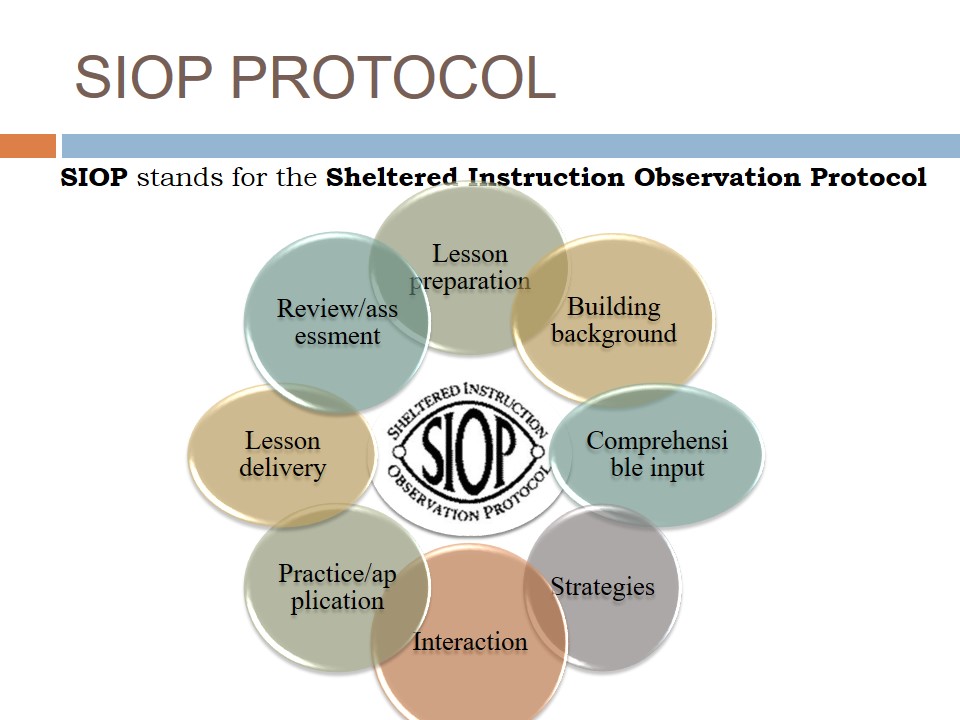
AZELLA in Ell Instructions
- A standard-based assessment that aims at measuring language proficiency.
- Arizona state measure students’ knowledge.
- Placement and assessment purposes.
- Once per year, till proficiency is achieved.
AZELLA stands for the Arizona English Language Learner Assessment (Faltis, 2013). It is a standard-based assessment developed by the state of Arizona and aims at measuring the level of language proficiency of English language students. It helps to develop effective placement and assessment of students, their skills, and needs. As a rule, it occurs once per an educative year to check if students are able to achieve the required level of proficiency or not.
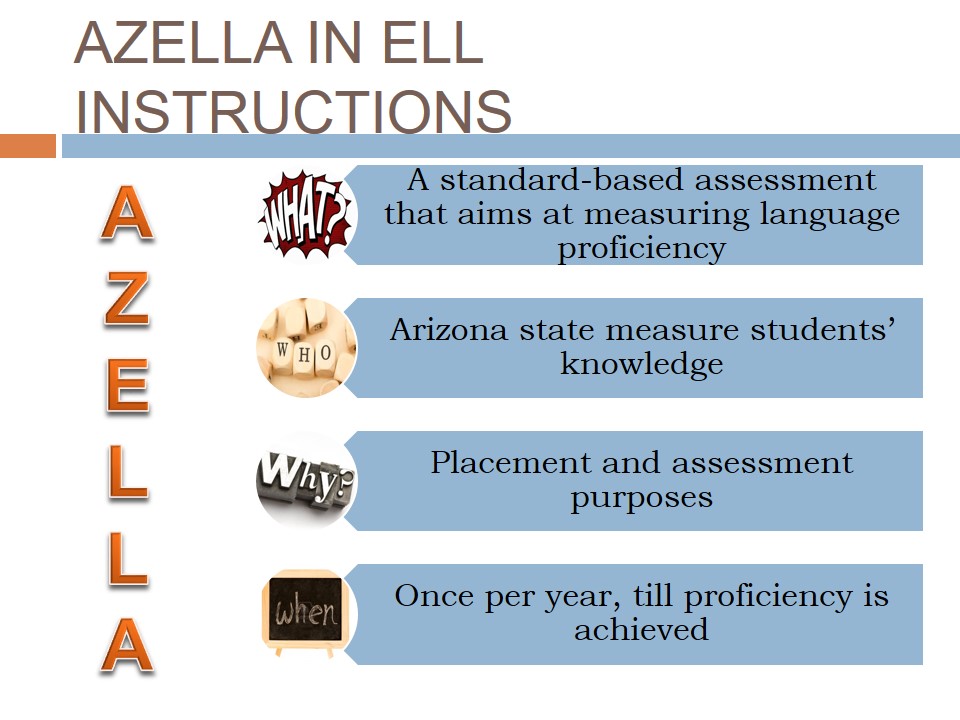
AZELLA Benefits
- Measurement of student language development.
- Application of formative and summative assessment.
- Reassessment test to clarify disabilities and improve a learning process.
- Placement test to understand students’ needs.
AZELLA is assessment with a number of benefits for Arizona teachers and students. On the one hand, teachers are able to measure students’ development, their language proficiency, and skills that have been already gained. Besides, it is possible to use two types of assessment to investigate students’ knowledge (summative and formative). On the other hand, students can make use of placement and reassessment tests once per year to demonstrate their progress or prove that some complications or challenges occur.
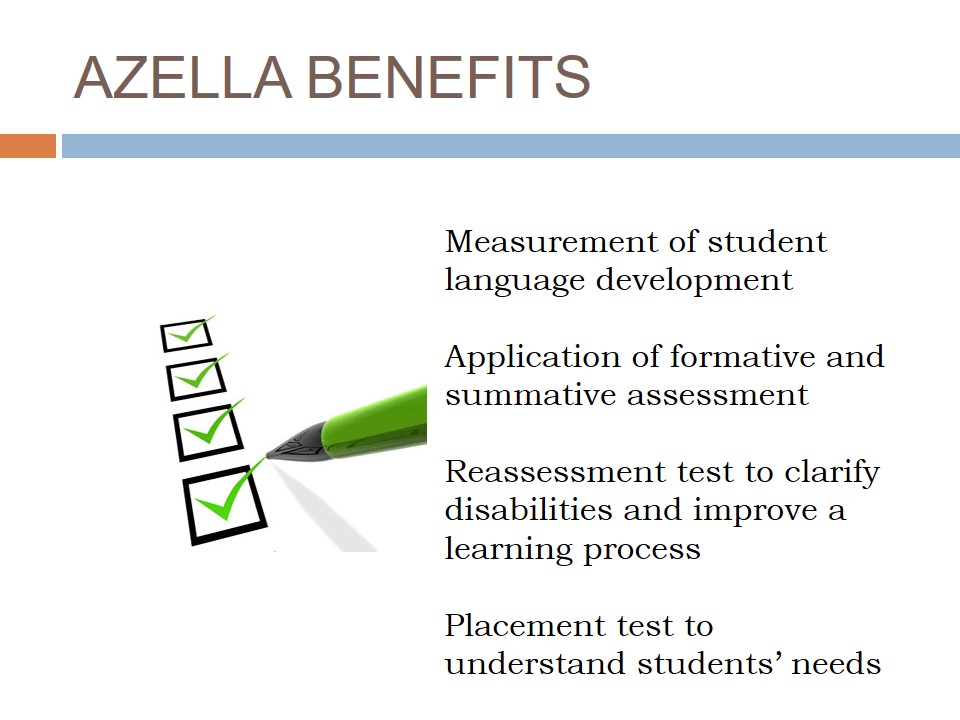
AZELLA And Student Achievements
AZELLA consists of three types of reports for teachers to identify students’ readiness to receive ELL services and determine expectations.
- History Report – the history of development of an individual student.
- Program Participation Report – the description of student’s activities.
- Roster Report – the analysis of student’s achievements.
ELLs have to take several AZELLA tests to prove their proficiency and readiness to work in classrooms with other students. There are three types of reports teachers use to investigate students’ knowledge, readiness, and skills. Each report contains the scores obtained by students. History reports (SDELL70) investigate the historical aspects of students; Program Participation reports (SDELL71) describe the current progress of a student; Roster reports (SDELL72) evaluate students’ achievements.

California Assessment
- In California, more than millions of students whose native language is not English.
- Student from kindergarten to the 12th grade have to assess their English language proficiency.
- CELDT is assessment in California that helps to identify students’ areas of improvement.
There are more than millions of migrant students whose native language is not English. They are defined as ELLs who have to take English language proficiency tests annually regardless if they are kindergarten students or K-12 students. In the state of California, CELDT is used to check this level of proficiency. CELDT stands for California English Language Development Test. It is used to check the progress of students in different areas, including reading, listening, speaking, and writing.

California Placement Process
CELDT is developed on the basis of Federal Law and State Law in order to:
- Identify California students with low or limited English language proficiency.
- Recognize the level of proficiency among those students.
- Determine if there is any progress with time.
As well as all Arizona teachers use AZELLA to identify students’ proficiency in the language and succeed in placement, California teachers use CELDT to test their students’ knowledge and abilities in writing, reading, listening, and speaking. There are five levels of proficiency: beginning, early intermediate, intermediate, early advanced, advanced. Each class is gathered in regard to students’ abilities and intentions to gain knowledge. It is expected, that in each class, approximately 45 minutes per day is spent on English language proficiency improvement on the basis of tests taken (Faltis, 2013).
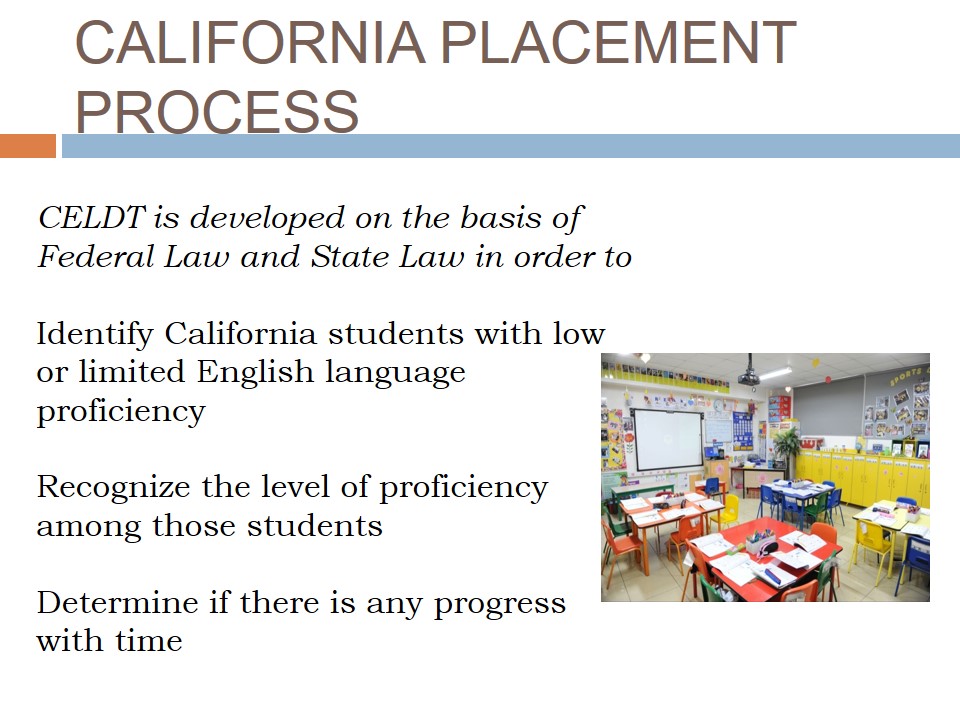
CELDT Benefits
- Four categories are measured by CELDT (reading, writing, speaking, and listening).
- Five levels are used in scoring (beginning, early intermediate, intermediate, early advanced, advanced).
- Promotion of funding.
- Evident student improvement and progress.
- Student involvement.
In California, CELDT is one of the best and most effective methods to assess ELLs’ levels of proficiency. In addition to such facts as the number of categories used for measurement and the levels of proficiency, the results of CELDT can be used to prove the importance of funding and the role of stakeholders in California student education. Student assessment is the recognition of students’ progress and abilities to learn new material relying on their past experiences (Solano-Flores, 2016).
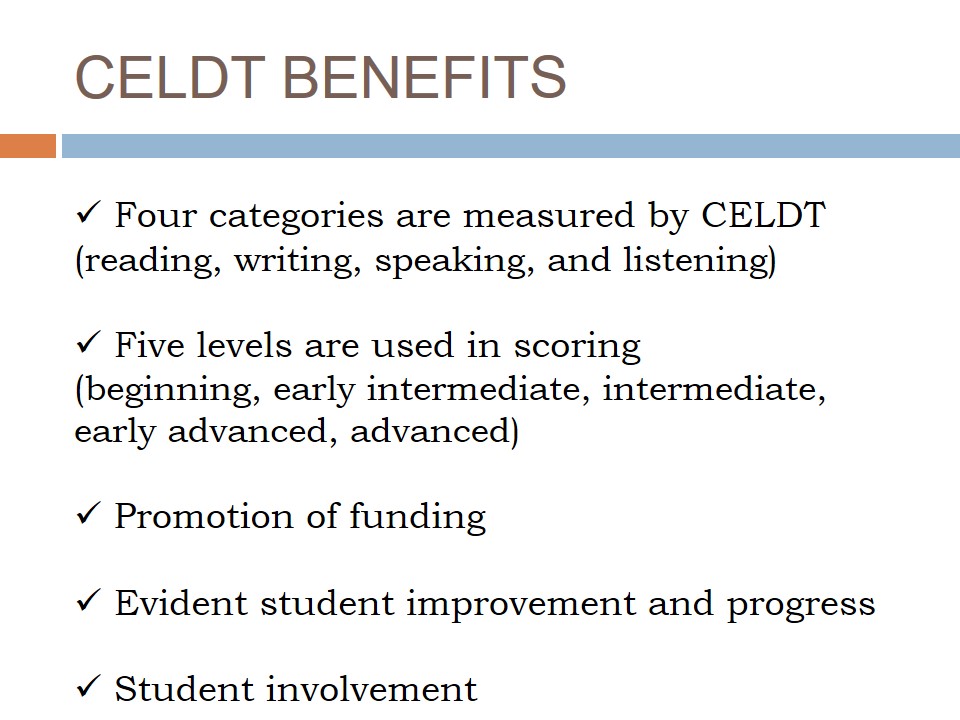
CELDT vs. AZELLA
- CELDT:
- California;
- Language proficiency;
- Four domains of ELD.
- AZELLA:
- Arizona;
- Language proficiency;
- Three stages of tests.
CELDT and AZELLA are important assessment methods in different states. Despite their location, both methods have their own benefits that facilitate achievements among ELLs. CELDT focuses on four main domains in English language development, and AZELLA recognizes different stages of English language development of every student. Language proficiency is the goal that has to be achieved in all states. There are many migrant students who do not use English as the main language for communication out of schools. Therefore, the presence of such tests and the necessity to meet certain standards motivate students and provide teachers with enough information to evaluation their students and achievements made in a certain period.
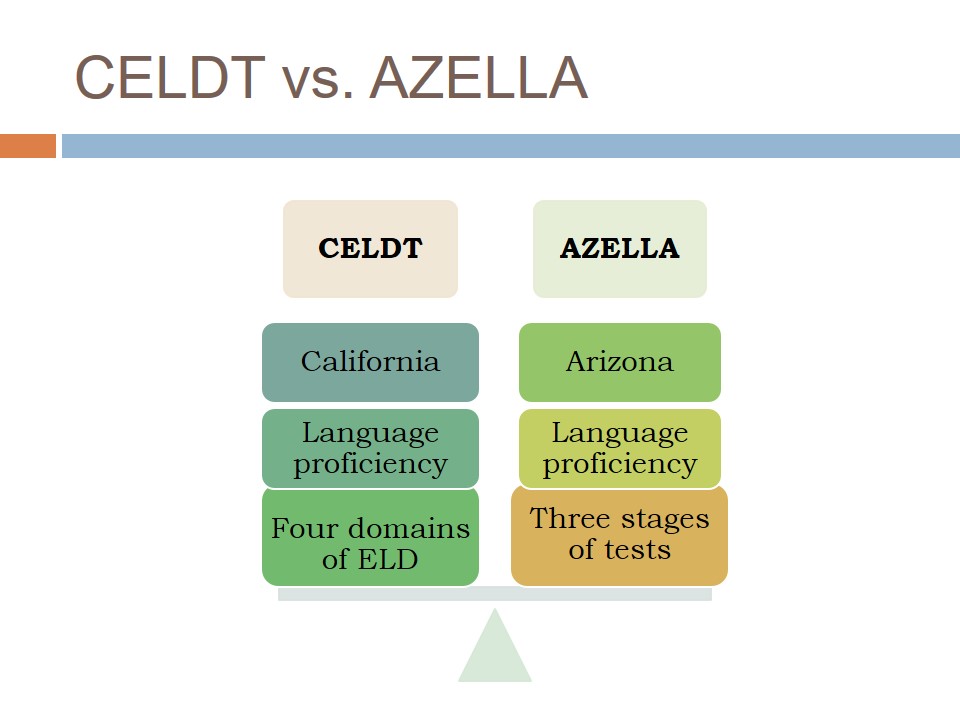
Concluding Remarks
- Assessment and placement play an important role in a learning process.
- Migrant students may demonstrate different levels of language proficiency.
- AZELLA and CELDT are effective methods for assessment and placement in the classrooms.
- Progress and underachievement of students have to be controlled by their teachers.
ELLs may face numerous problems and tasks. Assessment and placement are the integral parts of a learning process where first challenges may occur. It is necessary for migrant students to demonstrate their level of proficiency in order to be determined to a certain classroom with its own tasks and expectations. Each state in America has its own assessment tool. In California, it is CELDT, and, in Arizona, it is AZELLA. Both methods help to keep an eye on students’ progress and eliminate possible negative outcomes of underachievement in a learning process.

References
Alhasiany, F. (2014). English language learners. International Journal of Business and Social Sciences, 5(8), 38-43.
Faltis, C. (2013). Language, language development and teaching English to emergent bilingual users: Challenging the common knowledge theory in teacher education & k-12 school settings.” Association of Mexican American Educators Journal, 7(2), 18-29.
Solano-Flores, G. (2016). Assessing English language learners: Theory and practice. New York, NY: Routledge.